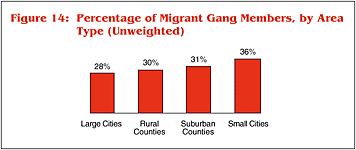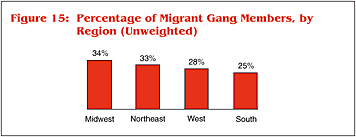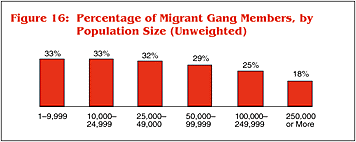|
The proliferation of gangs in the United States has resulted in increased interest in the role played by migration of gang members. Migration has been mentioned as a factor contributing to the spread of gangs in State legislative task force reports, government-sponsored conference presentations, and law enforcement reports at the local, State, and Federal levels (Maxson, Woods, and Klein, 1996). The conclusions of many of these reports, however, have been at odds with those of empirically based studies (Howell, 1998; Maxson, Woods, and Klein, 1996). For instance, a recent study of more than 1,100 cities concluded that migrant gang members have had less of an effect on the proliferation of gangs throughout the country than previously believed (Maxson, Woods, and Klein, 1996; Maxson, 1998).
In the 1996 National Youth Gang Survey, agencies that reported gangs in 1996 were asked if there had been any gang migration into their jurisdictions and what proportion of their gang members were migrants. Approximately 84 percent of respondents indicated that they had experienced some gang migration into their jurisdictions. When responses were weighted for the number of gang members reported in each jurisdiction, respondents that experienced some migration estimated that 21 percent of their gang members were migrants.
The average proportion of migrant gang members in jurisdictions that experienced gang migration was much higher when unweighted averages rather than weighted averages were used. Average unweighted proportions ranged from 28 percent in large cities to 36 percent in small cities (29 percent overall) (see figure 14). The weighted average proportion of migrant gang members is lower than the unweighted average proportion because there were fewer migrants reported in jurisdictions with large numbers of gang members. Conversely, a greater number of jurisdictions with few gang members reported a large number of gang migrants.
The ratio of migrants to all gang members also varied by region. Survey respondents in the Midwest that experienced some migration reported the highest average proportion of gang migrants, 34 percent, followed by 33 percent in the Northeast, 28 percent in the West, and 25 percent in the South (see figure 15). These variations in gang migration by region were found to be statistically significant.
Figure 16 illustrates the percentage of migrants by population size. Generally, as population size increased, the average percentage of migrants decreased. Agencies that experienced some migration in the two lowest population ranges (1-9,999 and 10,000-24,999) reported the highest average proportion of gang migrants (33 percent). In contrast, those that experienced some migration in the highest population range (250,000 or more) reported the lowest average proportion of gang migrants (18 percent). The variation in the average percentage of migrants by population size was statistically significant.
The survey results indicated that gang member migration was widespread and, to some degree, affected a large majority of the agencies reporting gangs in 1996. Further analyses of the migration data will be undertaken, and subsequent surveys will attempt to gather more information about the extent of gang member migration, particularly the underlying reasons for relocation.
|


